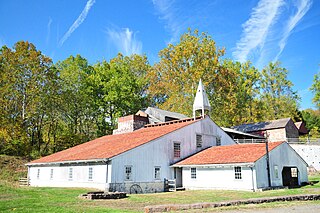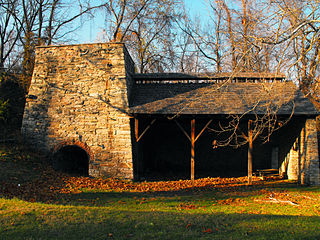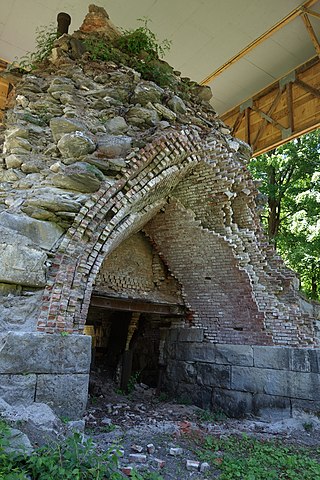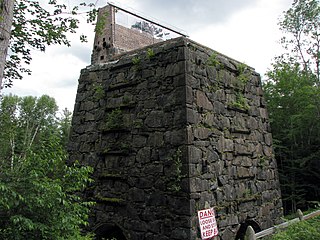
Sloss Furnaces is a National Historic Landmark in Birmingham, Alabama in the United States. It operated as a pig iron-producing blast furnace from 1882 to 1971. After closing, it became one of the first industrial sites in the U.S. to be preserved and restored for public use. In 1981, the furnaces were designated a National Historic Landmark by the United States Department of the Interior.

Hopewell Furnace National Historic Site in southeastern Berks County, near Elverson, Pennsylvania, is an example of an American 19th century rural iron plantation, whose operations were based around a charcoal-fired cold-blast iron blast furnace. The significant restored structures include the furnace group (blast furnace, water wheel, blast machinery, cast house and charcoal house), as well as the ironmaster's house, a company store, the blacksmith's shop, a barn and several worker's houses.

The Tannehill Ironworks is the central feature of Tannehill Ironworks Historical State Park near the unincorporated town of McCalla in Tuscaloosa County, Alabama. Listed on the National Register of Historic Places as Tannehill Furnace, it was a major supplier of iron for Confederate ordnance. Remains of the old furnaces are located 12 miles (19 km) south of Bessemer off Interstate 59/Interstate 20 near the southern end of the Appalachian Mountains. The 2,063-acre (835 ha) park includes: the John Wesley Hall Grist Mill; the May Plantation Cotton Gin House; and the Iron & Steel Museum of Alabama.

Oxford Furnace is a historic blast furnace on Washington Avenue, near the intersection with Belvidere Avenue, in Oxford, Oxford Township, Warren County, New Jersey. The furnace was built by Jonathan Robeson in 1741 and produced its first pig iron in 1743. The first practical use in the United States of hot blast furnace technology took place here in 1834. The furnace was added to the National Register of Historic Places on July 6, 1977 for its significance in industry during the 19th century. It was later added as a contributing property to the Oxford Industrial Historic District on August 27, 1992.

Carrie Furnace is a former blast furnace located along the Monongahela River in the Pittsburgh area industrial town of Swissvale, Pennsylvania, and it had formed a part of the Homestead Steel Works. The Carrie Furnaces were built in 1884 and they operated until 1982. During its peak, the site produced 1,000 to 1,250 tons of iron per day. All that is left of the site are furnaces #6 and #7, which operated from 1907 to 1978, and its hot metal bridge. The furnaces, designated a National Historic Landmark in 2006, are among the only pre-World War II 20th century blast furnaces to survive.

Cornwall Furnace is located near Cedar Bluff, Alabama in Cherokee County. It was built by the Noble Brothers to supply iron products to the Confederate States of America during the American Civil War.

Catoctin Furnace is a historic iron forge located on Route 15 between Frederick and Thurmont in Catoctin Furnace, Maryland. The smelting blast furnace is shown. No forge is at the site now. Forges were present when the ironworks was operational.

Principio Furnace and village is in Cecil County, Maryland, 4 miles (6.4 km) northeast of Havre de Grace, MD.

The Nassawango Iron Furnace was built in 1830 by the Maryland Iron Company to produce iron from bog ore deposits in its vicinity. It is notable for its innovative use of a "hot blast" technique for smelting the iron, which had been developed in England around 1828, and which may have been added to the Nassawango Furnace in 1837. Due to the variable nature of the bog ore deposits, the furnace stopped operations in 1849.

Stafford Hollow, also known as Stafford, Stafford Village, or Furnace Hollow, is a village in the town of Stafford, in Tolland County, Connecticut, located at the junction of Route 19 and Route 319. Stafford Hollow was the town center of Stafford during the 18th and 19th centuries, before the growth of the village of Stafford Springs.
The Eric Sloane Museum in Kent, Connecticut, is a museum featuring the studio and antique hand tool collections of Eric Sloane. It is owned and operated by the State Historic Preservation Office of Connecticut. The property includes the Kent Iron Furnace, a granite blast furnace which produced pig iron for almost 70 years, beginning in 1826. The furnace is listed on the National Register of Historic Places.

Lonaconing Furnace, also known as The George's Creek Coal and Iron Company Furnace No. 1, is a historic iron furnace in Lonaconing, Allegany County, Maryland, United States. It is a truncated square pyramid constructed of sandstone, 50 feet (15 m) high, 50 feet square at the base, and 25 feet square at the top. It first produced iron in 1839, then the iron operation was abandoned in the mid-1850s, the Loncaconing Furnace complex included a top house, molding house, engine house, and two hot-air furnaces for heating the blast. None of these ancillary structures remains. It played a significant role in demonstrating that both coke and raw bituminous coal could be used as fuels in the manufacture of iron. It is known as "the first coke furnace, whose operation was successful, erected in this country."

The Confederate Monument in Owingsville in Bath County, Kentucky, near Owingsville, Kentucky, commemorates the Confederate soldiers who hailed from Bath County. It is located in Owingsville Cemetery.
This is a list of the National Register of Historic Places listings in Stewart County, Tennessee.

Copake Iron Works Historic District is a national historic district located at Copake Falls in Columbia County, New York. The district includes 11 contributing buildings, three contributing sites, eight contributing structures, and three contributing objects. They are associated with the remaining vestiges of the Copake Iron Works, an iron extraction and production operation established in the mid-19th century. It includes the remains of a charcoal blast furnace, frame office and attached brick powder storage building, brick engine house and pattern shop, four frame workers houses, and a substantial Greek Revival dwelling. Also included in the district are a series of retaining walls, remnants of a cast-iron penstock, and a bridge abutment. Also located in the district is the previously listed Church of St. John in the Wilderness.

Adirondack Iron and Steel Company is a historic ironworks complex located at Tahawus in Essex County, New York. It consists of the remains of the "Upper Works" iron foundry that date back to 1826. Iron from the site was contaminated with titanium, which, together with its isolation, made for an unprofitable venture.

Laurel Hill Furnace is a historic iron furnace located at St. Clair Township, Westmoreland County, Pennsylvania. It was built in 1845, and is a rectangular cut stone furnace with four arches at its base. It remained in blast until 1855–1860. The furnace was donated to the Western Pennsylvania Conservancy in 1973.

Brady's Bend Iron Company Furnaces is a set of historic blast furnaces and rolling mill located in Brady's Bend Township, Armstrong County, Pennsylvania. The furnaces are constructed of stone, with the first blown into production in 1840. A second furnace was added in 1845. They were hot blast furnaces powered by a 250-horsepower steam engine. The rolling mill was also powered by a 250-horsepower steam engine and went into production in January 1842. The furnaces and mill were established by the Great Western Iron Works in August 1839, and is considered by some the "Pittsburgh of the Middle 1800s" and "Cradle of the Iron and Steel Industry in America." It was known as the Brady's Bend Iron Company after 1844. The company was credited with manufacturing the first T-rails west of the Allegheny Mountains. The works closed in 1873.

The Beckley Furnace Industrial Monument is a state-owned historic site preserving a 19th-century iron-making blast furnace on the north bank of the Blackberry River in the town of North Canaan, Connecticut. The site became a 12-acre (4.9 ha) state park in 1946; it was added to the National Register of Historic Places in 1978.

Callie Furnace is a historic iron furnace located near Glen Wilton, Botetourt County, Virginia. It was built as a hot-blast charcoal furnace around 1873–1874, and subsequently enlarged and converted into a coke furnace. In 1883, the stack was raised an additional five feet, and a tuyere was added. Callie Furnace went out of blast in 1884.




















